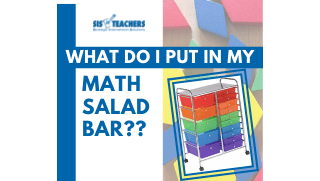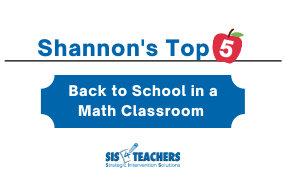We mapped out our quarterly promises, looked at data within the district, and identified power standards. But how would we know if it was working??

Missed an episode? See the whole Instruction by Design Series here.
At this point, it was time for us to look a little bit deeper at how we were assessing kids to see if what we were doing was really effective. Within the process of instruction by design, there are five different assessment elements: formative, interim, performance tasks, student reflection, and summative. Each type of assessment adds another layer to the data that can help us determine the best, most effective, instruction for each student.
Formative Assessment
 While we’ve talked about formative assessment in other blogs, it is a vital part of day-to-day instruction, and it is always worth talking about again! Teachers use formative assessment every day – it’s just part of good teaching! It may not always be a formal exit ticket or anything, but before a lesson, formative assessment identifies how well students are grappling with a concept. In the middle of the lesson, during direct instruction or exploratory instruction, formative assessment is observing students as they interact. At the end of the lesson, while planning for the next day, formative assessment will review the progress of daily work or homework that is assigned. etc. It might take the form of an exit ticket, a pre-test or even a jot lot that teachers can use to gauge the students’ progress and the immediately use that information to drive instruction.
While we’ve talked about formative assessment in other blogs, it is a vital part of day-to-day instruction, and it is always worth talking about again! Teachers use formative assessment every day – it’s just part of good teaching! It may not always be a formal exit ticket or anything, but before a lesson, formative assessment identifies how well students are grappling with a concept. In the middle of the lesson, during direct instruction or exploratory instruction, formative assessment is observing students as they interact. At the end of the lesson, while planning for the next day, formative assessment will review the progress of daily work or homework that is assigned. etc. It might take the form of an exit ticket, a pre-test or even a jot lot that teachers can use to gauge the students’ progress and the immediately use that information to drive instruction.
Interim Assessment
An interim assessment is administered at different intervals (hence the name) between instruction (source: NWEA Blog). Interim assessments might be included in the textbooks in the form of a mid-module assessment or a quick check up, which are great within the context of the book. However, remember that the assessments in the book are assessing whether or not the content that you’ve identified and delivered from the textbook is going well.
Without interim assessments or a mid-module check-in, here’s a typical scenario: We teach the lessons as laid out in the book, collect some formative data from independent work, and give the end-of-chapter test at the end. We find that 34% of kids pass the test, and we move on to the next chapter.
It’s important that interim assessments be a part of the curricular framework when we’re looking at instruction by design so we know that the pieces of the framework we’re designing are effective the way we’re teaching them and we can catch the kids that don’t get it before we move on. As we developed our own curricular framework, I really wanted our interim assessments to be standards based, especially as we considered our quarterly promises.

We began to search for standards-based assessments that would allow us to focus particular attention on our power standards and gathering data on those heavy-hitter standards identified with a green checkmark. But we also wanted to incorporate depth of knowledge (DOK) level (read more about depth of knowledge here!).
We were in luck! We found a really great resource that had everything we were looking for – for free! CCSS Math Activities (https://www.ccssmathactivities.com/)has great snapshot assessments for each grade level, K-5! Each assessment has about four questions on one standard and also includes the DOK level of each of those questions. It is a great direct match to what our state tests and assessment claims look like.

To access the snapshot assessments for your grade level, click K-5 Supports in the navigation menu at the top of the website, then select Engage NY and choose your grade level. You can also click here to choose your grade level: https://www.ccssmathactivities.com/engageny-support/
Ironically, it was organized for the Eureka Math program (which our schools already used), so it was already laid out in modules, which was an easy parallel. However, since the resource is standards-based, we’ve used these lines of assessments by DOK levels for other schools that don’t use Eureka Math with no problems.
In our journey to instruction by design with our districts, we analyzed these snapshot assessments and made some changes that tailored them to the quarters we had mapped out in our quarterly promises, and we were able to select the assessment that we thought would best determine whether or not the student was getting that standard. Some of the units we developed only had two interim assessments, some of the larger units had up to five interim assessments. Of course, we still used traditional tools like exit tickets, but we used the snapshot assessments to collect data that answers the question Is the curriculum we’re writing effective?
For data collection purposes for our districts, we use the initial score, but in our trainings, we’ve talked about how, when we find a pocket of kids that are still struggling with a particular concept, we continue to work on that standard. We know that standard will come up again in the summative assessment and other things the student will be looking at.
Performance Tasks
Performance tasks “build on earlier content knowledge, process skills, and work habits and are strategically placed in the lesson or unit to enhance learning as the student ‘pulls it all together.’ […] Performance tasks range from short activities taking only a few minutes to projects culminating in polished products for audiences in and outside of the classroom.” (Source: ASCD)
How do you take a performance task and make it personally beneficial for students? For our instruction by design project, each unit was designed around a theme, like area or decimal place value. Each unit addresses essential questions that were designed to show how that theme relates to the students we’re working with and how they would use it in real life. And so we selected/created performance tasks to fit within those units.
 Performance tasks should be set up to be personal and relatable to the student as to where they’re going to apply the math in their life, so we had to tweak some of the tasks based on our students’ geography and socioeconomic background. In the Upper Peninsula, the kinds of performance tasks or questions that we might use are going to be different than those that would be relatable in Lincoln Park, which has more of an at-risk population.
Performance tasks should be set up to be personal and relatable to the student as to where they’re going to apply the math in their life, so we had to tweak some of the tasks based on our students’ geography and socioeconomic background. In the Upper Peninsula, the kinds of performance tasks or questions that we might use are going to be different than those that would be relatable in Lincoln Park, which has more of an at-risk population.
For example, say the performance task asks the student to build a fence of a specific size to keep their horses contained. For a child that lives in the city or hasn’t experienced a horse farm, that might not be a great performance task because, while both the math and application are sound, the students can’t relate. It doesn’t fit into their world. Now, would it be a great performance task for some of my schools in Wyoming? Absolutely! But it won’t work for everyone. Maybe, for city kids, the question might still be about area and fencing, and length and width of a spot, but maybe, instead the student is asked to build a planter or garden in the school yard.
We allotted one instructional day for students to complete the performance task and for teachers to be able to collect data from the task.
We have lots of resources on our Math Resources page regarding performance tasks – where to find them, rubrics, etc. https://sis4teachers.org/math-resources/ (click on the Writing/Problem Solving tab).
Student Reflection
As students complete performance tasks, we can get a more accurate picture of where they are in the real life application of the skills for that unit using N.A.P.E. – are they novice? Apprentice? Practitioner? Or expert?

At first, when teachers look at this, they think, “oh, the kids are just going to talk about how they feel about math??” But as we’ve been rolling this out during the school year, the teachers are seeing that this is really a valuable piece. The students are being asked five questions about the standard, and whether they feel like they’re a 1 (novice), 2 (apprentice), 3 (practitioner), 4 (expert) in that area.

Students can reflect before, during or after the unit, but the goal is to assess how the student feels about where they are with the content. Self-reflection will help them consciously process what they’re learning – Do they know the theme of the unit is? Why we’re learning about it? Where it will apply to your everyday life? How do you feel about applying these skills in your everyday life?
Although, at first, it seems like just one more thing, but it’s a really crucial piece that allows us to gauge where students are with the content. If kids are aware of the objectives for a lesson or a unit, can relate to the essential questions we’re trying to answer, and understand why we’re learning about these things, they definitely feel more connected to the instruction that’s going on than they would if we were going through a textbook that gives them the next page, lesson, and worksheet.
Summative Assessment

This type of assessment looks at the finality of how well a child is doing in a certain area. Summative assessments might be as big as a district administering a state or standardized test like the M-STEP, STAAR, etc., but for our instruction by design project, we wanted a summative assessment that happens at the end of the unit that we’ve designed to see if, through those interim assessments and performance tasks and the things we’ve done, the child mastered those standards we set out.
The end-of-chapter, module or unit tests are there in the book, and again, they’re great for the “middle of the road” approach of the textbook, but does that really work with the population of kids you’re working with? Is it really assessing what you sought to teach in that particular unit that you designed? The answer for me is no.
We collected data all year in our project school districts using Eureka Math and their end-of-module assessment. The data told me that only 34% of the kids were passing. It gave me little to no information on how to help the at-risk kids improve. So we had to start looking at data differently. What was the summative assessment going to be made up of? It needed to be similar to our interim assessments, but instead of just looking at one standard, encompassing all of the standards from the unit. It also needed to look at DOK level to incorporate the 8 mathematical practices into what we were assessing.
Using Illuminate (the data collection system used by the district we were working with), we created standards-based assessments (you can decide if you want to use Common Core standards or not). We searched by the type of standards we were looking for and by DOK levels to create online Illuminate assessments, similar to what the district used last year. But instead of the assessment being about every single piece of the textbook, it was assessing those standards and targets we were trying to hit within our unit. We left one day of instruction at the end of the unit for students to take their Illuminate test as a summative assessment.
Now What?
If we had all five of these data pieces in place, wouldn’t we have a much better handle on what we were implementing and if what it was really working? And if it wasn’t working, with all the five layers of assessment data available, I could see exactly which standard is the issue so I could design the curriculum to address that standard.
 While we were working with our districts, we ended up creating a binder called our Assessment Binder. We encouraged teachers, after they create their units, let’s look at what are really good exit tickets or formative assessment pieces that you might want to hang on to so you can refer back to it. So, in their assessment binders, teachers include their interim assessments, their student evaluations, they can easily put in their formative assessment data, they have a copy of their summative assessment and performance tasks for every unit. This binder becomes a planning tool so they can really be thinking about what they’re trying to show improvement on.
While we were working with our districts, we ended up creating a binder called our Assessment Binder. We encouraged teachers, after they create their units, let’s look at what are really good exit tickets or formative assessment pieces that you might want to hang on to so you can refer back to it. So, in their assessment binders, teachers include their interim assessments, their student evaluations, they can easily put in their formative assessment data, they have a copy of their summative assessment and performance tasks for every unit. This binder becomes a planning tool so they can really be thinking about what they’re trying to show improvement on.
Because Instruction by Design is looking at the end in mind, we want to be able to look at the target of where we want kids to be. The next step (which we’ll talk about next week) is now what? We have quarterly promises, we have assessments lined out and created, now what is the instructional resource of the curriculum that we’re creating?



